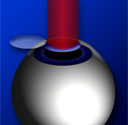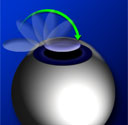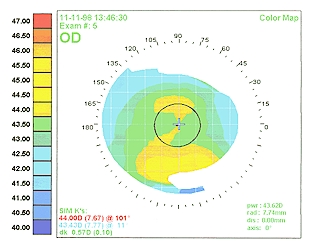|














- Palisades Office:
- 970 Monument St. #204
- Pacific Palisades, CA
- (310) 454-5521
- Studio City Office:
- 12229 Ventura Blvd.
- Studio City, CA
- (818) 623-8900
-
-
| |
How LASIK works | Am I a candidate for
LASIK? | Who can have LASIK?
LASIK results | Your
LASIK consultation
Your LASIK surgery | Possible side
effects and complications
LASIK (Laser In Situ Keratomileusis) is the most popular type of vision correction procedures or refractive surgery. LASIK uses the excimer
laser to correct nearsightedness, farsightedness, or astigmatism by modifying the shape of the cornea
to improve your vision.
nearsightedness, farsightedness, or astigmatism by modifying the shape of the cornea
to improve your vision.
How LASIK works
LASIK uses the excimer laser to reshape the clear dome-shaped cornea on the front of the
eye so that light will be properly focused
to achieve a sharp image on the retina:
| STEP 1. After a drop of
anesthetic is applied to the eye, an instrument known as a
microkeratome is used to create a thin flap of corneal tissue,
which is folded back. |
 |
| STEP 2.
While the patient looks at a blinking red light, the
excimer laser
removes a predetermined amount of tissue from
the inner cornea to correct their refractive error. The
cornea is made flatter to treat nearsightedness, steeper to treat
farsightedness and/or more spherical to correct astigmatism. |

|
| STEP 3. The
corneal flap is placed back in its original position where it
bonds without the need of stitches. LASIK can treat low to very
severe refractive errors.
The procedure results in a rapid recovery, allowing most
patients to resume to normal activity within one to two days. Results are
overwhelmingly successful.
|

|
|
You are probably a good candidate for LASIK if the answer to the following
questions is "Yes:"
1. Is your eye prescription
stable? Has it been about the same for at least one year?
2. Are you 18 years of age or
older?
3. Would you like to have the
freedom from dependency on your glasses or contact lenses?
4. Do you have less than 10 diopters of myopia (nearsightedness), 5 diopters
astigmatism, or 4 diopters hyperopia (farsightedness)?
AND the answer to the following questions is "No:"
Do you have any corneal
diseases such as keratoconus or herpes infection of the eye?
Are you currently pregnant or
planning to become pregnant in the near future?
Do you have any retinal disease?
Over 95% of LASIK patients achieve unaided distance vision of 20/20 or better without an enhancement procedure. Vision improvement is rapid with most of the improvement apparent on the first day after the procedure. While
slight fluctuations in vision can occur in the first week, most patients return
to regular activities the next day.
Your LASIK consultation
Preparing for your consultation
- Please bring your current glasses, previous glasses or your contact lenses
to the examination.
- It is best not to wear soft contact lenses within one week of the consultation
or hard contact lenses for four weeks prior to the LASIK evaluation. This will
allow the surface of your cornea to resume its normal shape.
- Your eyes will be dilated during the examination; therefore you should
bring sunglasses to assist you in driving home after the examination.
Your consultation
Your LASIK consultation will include a comprehensive eye examination and special
testing to design a treatment plan for your individual needs. The testing will
include:
- A refraction (a measurement of the optics of your eye)
- Topographic mapping of the
surface of your eye.
 This computerized image maps the curvature of the cornea, similar to a geological relief map (see example
at right). Each color represents a different steepness of curvature. The exam mapping shown at the right is an example of a corneal map indicating astigmatism.
This computerized image maps the curvature of the cornea, similar to a geological relief map (see example
at right). Each color represents a different steepness of curvature. The exam mapping shown at the right is an example of a corneal map indicating astigmatism.
- A dilated refraction to verify your prescription and check for retinal disease
- A comprehensive discussion of your individual eye health and recom-
endations for your refractive laser surgery.
Your LASIK surgery
Preparing for your laser surgery
- Discontinue soft contact lens wear at least one week prior and hard contact lenses at least one month prior to the laser
procedure. This will
allow the surface of your cornea to resume its normal shape.
- After your surgery, you will need a friend or relative to drive you home. It is best to rest quietly with the eyelids closed for most of the
remainder of the day.
Your laser surgery
- You will check in one hour prior to your scheduled surgery time for preoperative testing, forms, eye drops, and a mild sedative (Valium) to help you relax.
- You will remain awake and comfortable during the laser procedure. A
numbing topical anesthetic drop will be put into your eye and sterile drapes applied.
- The LASIK procedure takes approximately 8 minutes per eye and typically involves no discomfort. There is a slight pressure sensation experienced for a few seconds while the LASIK flap is created.
- When the surgery is complete, you will be escorted to an examining room for a post-operative check. The post-operative instructions will be reviewed and then you will be ready to return home.
- Please remember all patients need to be escorted home from the surgery. You should plan to be at the
Laser Center for a total of approximately 2 hours.
After your laser surgery
- For the first day and night your eye will be protected with a clear
plastic shield. The shield can be removed the morning after surgery by the patient, but should be reapplied at bedtime for the first 5 days.
- Upon arriving home, sleep and relaxation for the eye are best for
recovery. Keeping the eyelids closed keeps the cornea moist and speeds recovery.
- You will need to follow post-operative instructions for the eye drop
medications beginning the day after your laser procedure.
- While most patients experience little or no discomfort after LASIK
surgery, some do experience low to moderate sandy or foreign body sensation. This is relieved with use of the post-operative drops including artificial tears.
- You will return to Dr. Sawusch's office the next day for your one-day
post-operative exam. Follow-up appointments are generally scheduled for one day, one week, and one month following surgery.
For more information, see our frequently
asked questions (FAQ).
Possible side effects and complications
As with any type of surgery, complications are possible. Every effort is
made to minimize risks, but serious or long-term complications can never be
fully eliminated. Common side effects after refractive surgery include:
- Dry eyes most patients experience transient dryness of the eyes
which my require use of artificial tears or punctal plugs. Increased dryness of
the eyes typically lasts 3 or more months and rarely may be permanent.
- Glare from bright light sources, such as oncoming headlights while
driving at night may occur but generally improves and often resolves over
the first six months after the procedure. In a few cases, patients use eye
drops to keep the pupil small, thereby reducing glare. Wavefront or custom LASIK has reduced the liklihood of developing glare or halos.
- Shadowing, doubling of vision, or "ghost images" usually
resolves on its own, but sometimes requires further treatments.
- Variable vision may occur depending upon the procedure for weeks to
months after the procedure. Some individuals experience a small fluctuation
in the precise focus over the course of the day. This daily fluctuation
generally subsides during the month after the surgery.
- Overcorrection and undercorrection occurs in some patients who feel
that the uncorrected vision is not as good as desired. This may require the
use of glasses, contact lenses, or a laser enhancement procedure.
- Inflammation occurs occasionally under the LASIK flap and requires
increased use of anti-inflammatory eyedrops until resolved.
|